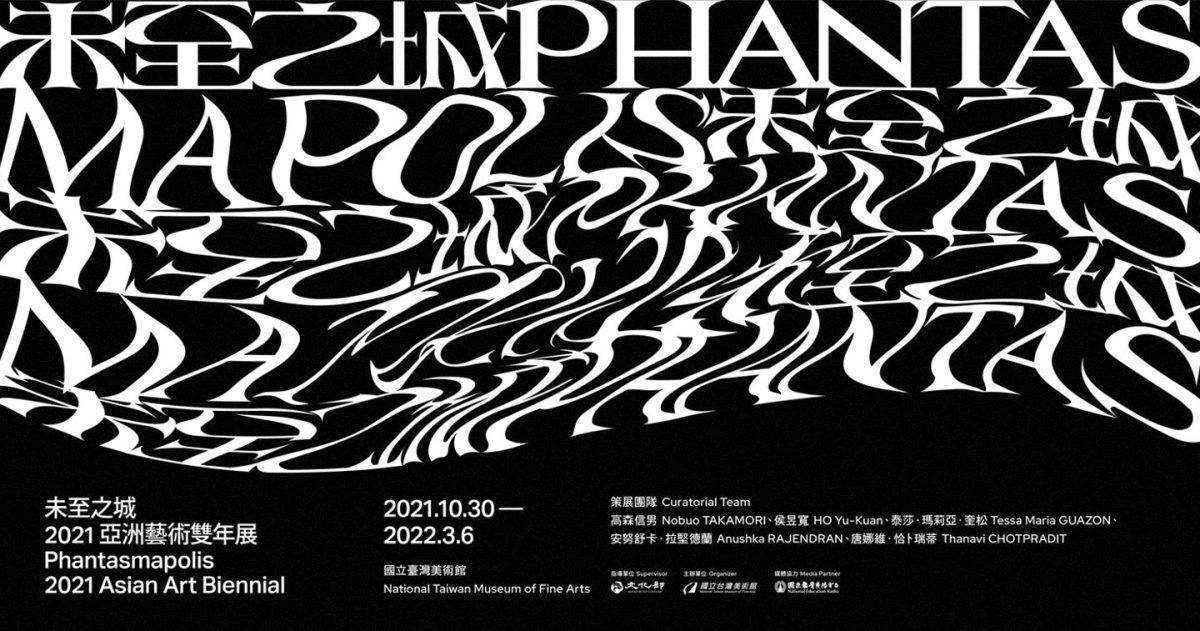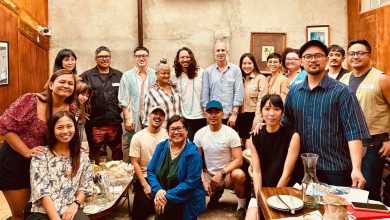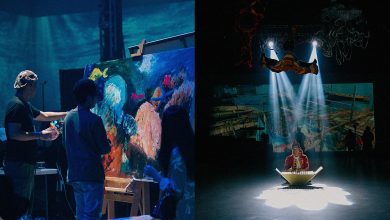TAICHUNG, TAIWAN — Phantasmapolis – The 2021 Asian Art Biennial hosted by the National Taiwan Museum of Fine Arts (NTMoFA), which is subordinate to the Ministry of Culture, will be open to the public on October 30. The NTMoFA announces the full artist list today and premieres online a short film recorded by representatives of the featured artists as well as a promo video of the Biennial, hoping to utilize audiovisual permeability and broadcast digital signals across the world to announce that the adventure into Phantasmapolis has now officially begun.
The Taiwanese independent curator Nobuo Takamori serves as the chief curator of the 2021 Asian Art Biennial. Adopting a multi-curator system, he invites Taiwanese curator Ho Yu-Kuan, Filipino curator Tessa Maria Guazon, Indian curator Anushka Rajedran, and Thai curator and art historian Thanavi Chotpradit to form a multinational curatorial team. With “Asian Futurism” and “Asian sci-fi culture” as the main themes, the Biennial re-evaluates Asia’s past and present through sci-fi perspectives by inviting thirty-eight artists/art groups from fifteen countries to re-examine topics about Asian cities, technologies, conflicts, gender, and fantasies of the future, co-creating the unknown Phantasmapolis that is closest to the future.
Director of the NTMoFA Liang Yung-Fei states that the 2021 Asian Art Biennial, as a crucial platform where Asian contemporary art converges, aims to deepen the network of cultural exchange through the participation of artists from different Asia-Pacific regions. Taking a broad view of the artists featured in the Biennial, there are not only emerging artists from Cambodia, Indonesia, Korea, Laos, Thailand, and Vietnam but also artists from Mongolia and Kuwait, introducing a wider and more diverse Asian cultural horizon to the audience.
This year’s Biennial artist list, unlike previous editions, is announced in a pleasantly surprising way. The exhibition team specially invites eleven artist representatives from Taiwan, the Philippines, India, Japan, Korea, Vietnam, Thailand, and Cambodia to speak about their imagination of Phantasmapolis in their native languages via a short film, attempting to respond to the diverse possibilities of Asian Futurism. The short film, together with the promo video of the Biennial, forms an invitation to Phantasmapolis.
Among the artist representatives, the work of Taiwanese artist HUNG Tung-Lu demonstrates the avant-garde aspect of Taiwanese contemporary art in the early 21st century. Hung’s early work is known for utilizing subcultures, the anime style, and multimedia to explore the real and virtual qualities of media’s role and the possibilities of media space. The artist will especially create a “remake” of his Reddie series of 2002 for the Biennial. The artist LIN Shu-Kai’s works are connected with his family history and convey the artist’s imaginations of future cities. This project is based in the closed factory that belonged to Lin’s father, portraying the past glory of the factory and Lin’s imaginations about future cities through molds, paintings, and images. He states that Phantasmapolis is a history co-created by the entire human race—although it has yet to happen, we are now creating it.
The work of Indian photographer Sharbendu De embodies profound philosophical thinking about culture and nature. She asserts that, in the complex, pluralistic future, humanity will face new challenges presented by species ecology and the environment of their survival. Korean artist Ayoung Kim, who was featured in the Venice Biennale, records the short film with various face lenses to connect and echo the diverse future unveiled through the exhibition theme. Emerging Vietnamese artist LÊ Giang utilizes a classical language to develop a unique style posited between the real and the fictitious as well as history and representation. Having witnessed the impact of the pandemic, she imagines that the future world will undergo reconstruction because of humans’ longing for freedom and fear for the pandemic.
The curatorial team further states that in addition to proposing their imagination of the future, the works of some of the artists showcased in the Biennial have created works involving multiple art forms, which not only produce unique visual experiences but also render Futurism a piercing instrument to engage in discourses about historical, socio-political and economic issues.
Emerging Thai contemporary video artist Chulayarnnon Siriphol excels in using motion image and individual body as his main creative media. His short films have been featured in special screenings of various international film festivals, such as the International Film Festival Rotterdam and the series of “Ten Years In Thailand” at the Cannes Film Festival. With an approach of sarcasm, Siriphol questions and explores contemporary issues and political ideas. Posited between the realistic and the surreal, his work displays an expression informed by his characteristic sensibility. One of the most important contemporary artists working with image, Lim Sokchanlina’s practice engages in diverse art forms, including photography, video, installation, and conceptual performance. Using different strategies, he brings the audience’s attention to changes in Cambodia’s international position, its geopolitics, culture, economy and environment in relation to the influence of globalization.
Phantasmapolis – The 2021 Asian Art Biennial will run from October 30, 2021 to March 6, 2022. While featuring artists and their works from various Asian countries, the Biennial also includes contemporary art, the NTMoFA collection, archival research, reader publication, and architectural creation. Continuing the exhibition theme, the Biennial will further extend to a series of brilliant plans, including video programs, literature exhibitions, special screenings, forums, and publication of academic readers. The latest information, artwork highlights, and artist introductions related to the Biennial will be released soon. Please follow closely the updates on the Facebook fan pages of the NTMoFA and the Biennial.
An Invitation from Phantasmapolis-online screening platform
YouTube:https://reurl.cc/eEq007
Facebook:https://reurl.cc/6aAVLM
Phantasmapolis: 2021 Asian Art Biennial
Time: October 30, 2021 to March 6, 2022
Exhibition Coordinators: Lin Hsiao Yu, Liao Chia-Cheng ,
Tel: (04)23723552 #304、701
Facebook: https://www.facebook.com/aabntmofa
National Taiwan Museum of Fine Arts
Opening Hours: Tuesdays to Sundays, from 09:00 to 17:00; closed on Mondays
Address: 2, Sec. 1 Wu-Chuan W. Rd., Taichung 403 TAIWAN
Tel: (04) 2372-3552
Official Website: http://www.ntmofa.gov.tw
Facebook: https://www.facebook.com/ntmofa
Full list of the 38 participating artists/artist groups
(listed according to alphabetical order of last names)
Catalina Africa (Philippines)
Bakudapan Food Study Group (Indonesia)
Bang & Lee (South Korea)
Shu Lea Cheang (Taiwan)
CHEN Chen Yu (Taiwan)
CHEN Chun Yu ((Taiwan)
Genevieve CHUA (Singapore)
Sharbendu De (India)
Mattie Do (Laos)
GAN Siong King (Malaysia)
HE Kunlin (China)
HIRATA Minoru (Japan)
Joyce HO (Taiwan)
HUNG Tung Lu (Taiwan)
ISOMURA Dan + UNNO Rintaro (Japan)
KIM Ayoung (South Korea)
KIMURA Tsunehisa (Japan)
LÊ Giang (Vietnam)
LEE Yung Chih (Taiwan)
LI Yi Fan (Taiwan)
LIN Shu Kai (Taiwan)
LIU Kuo Sung (Taiwan)
LIU Yu + WU Sih Chin (Taiwan)
Yuko MOHRI (Japan)
Hootikor (Lama-Motis & Cheku-Chelagu, Taiwan)
UuDam Tran NGUYEN (Vietnam)
office aaa (Taiwan)
OGINO Shigeji (Japan)
Pad.ma (CAMP & 0x2620, India)
Monira Al Qadiri (Kuwait)
Mark Salvatus (Philippines)
Chulayarnnon Siriphol (Thailand)
Lim Sokchanlina (Cambodia)
TAN Zi Hao (Malaysia)
WANG Jun Jieh (Taiwan)
Yuyu YANG (Taiwan)
Tuguldur Yondonjamts (Mongolia)
Alvin Zafra (Philippines)









